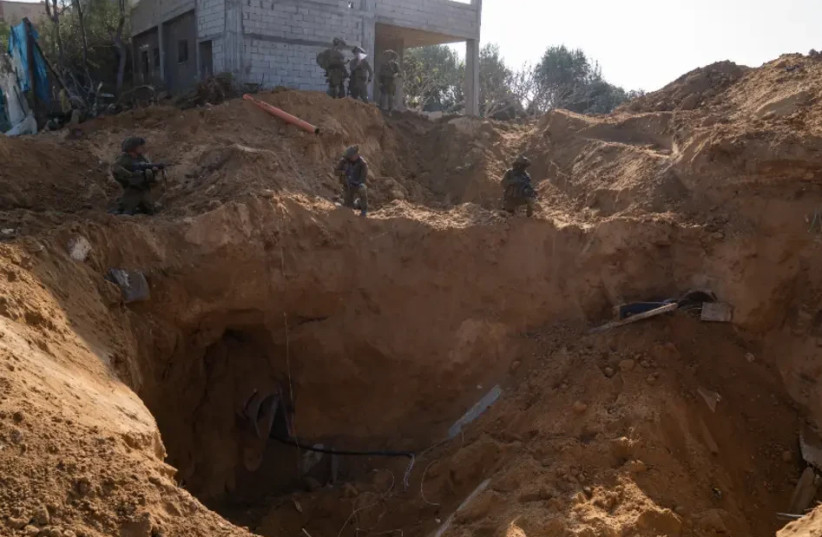Israel cannot rule out terror tunnels under West Bank settlements, expert says
After years of hearing about the tunnel threat in the North and South, now the residents of the Seam Line fear the threat has expanded to the eastern front. Dr. Daphne Richemond-Barak, an expert in the field, explains in an interview with Maariv why this is nothing less than an oversight.
In parallel to the IDF’s extensive activity to destroy Hamas’s terror tunnels in the Gaza Strip, this week, the IDF will mark five years since the end of Operation Northern Shield, during which six Hezbollah tunnels that penetrated Israeli territory were located. The decision to launch the extensive activity in December 2018 was preceded by repeated reports of digging noises by residents of Israel’s northern border, many of whom are currently forced to stay outside their homes following the exchange of fire at the border.
In recent weeks, after many years in which we have become accustomed to hearing about the underground threat in the north and south, similar complaints have been forwarded to the Israeli security forces by the residents of the seam line, raising the fear of the expansion of the tunnel threat to the eastern front as well.
“In the two years before the discovery of the tunnels in the north, there were many residents who complained, but at first they were not believed,” recalls Dr. Richemond-Barak, a senior lecturer at the Lauder School of Government, Diplomacy and Strategy at Reichman University, who recognizes a great similarity between the various arenas.
Having gained substantial experience in researching Israel’s underground threats, she is convinced that the publications in the media concerning the region of Emek Hefer and the Sharon point to a failure of the security forces.

“Even if there is currently no real threat, once we realized that our enemies are using the underground in all sorts of ways, we had to anticipate and prepare for such a threat. “How can this be a surprise to anyone at this point, when we know that there are tunnels in Gaza, in Lebanon, and the entire Middle East?
“In addition, we know that in Jenin, underground infrastructure was found six months ago. If they are digging inside Jenin, why wouldn’t they try to dig under the green line now? If there is evidence of digging inside Jenin, why wouldn’t we find tunnels in Bat Hefer? The pattern is being repeated in each of the arenas. As soon as we see activity in one arena, we need to be proactive and realize that we may see the same activity in other arenas as well.”
And in the arena in question, there is no separation between Jewish and Palestinian settlements, which may increase the level of threat.
“This is a very important point. Theoretically, such tunnels could be inside Jenin, under the Green Line, or between Jewish and Palestinian settlements. We must not rule out such a possibility. If we understand that they know what to do with the knowledge and how to maximize the solution, then it could certainly be that they dug tunnels between Jewish and Palestinian settlements. It’s entirely possible.”
How complex is the excavation in this area? Are there significant differences between the types of soil?
“If you have to rank the level of difficulty according to the type of soil, then you can say that the soil that is easiest to dig in is the sandy soil of the Gaza Strip. In Judea and Samaria, digging is more complex than in the Gaza Strip, and on the Lebanese border, it is the most difficult to dig, but what is important to say in this context is that we know even if the type of soil is a little more difficult to dig, it still doesn’t stop the enemy. Look at Hezbollah carving tunnels in stone. Such difficulties do not deter any player in the arena.”
Since the discovery of the first tunnels in the Gaza Strip, Israel has invested many resources in developing a technological solution to the underground challenges.
In 2015, the operational deployment of a system manufactured by “Elbit” began, to locate underground tunnel mining. In October 2017, it was cleared for publication that the Southern Command established a technological laboratory for locating tunnels, which includes experts in various fields who analyze the information collected by the system.
Alongside the technological solutions, the “barrier” was erected on the border of the Gaza Strip, an underground wall tens of meters deep designed to stop the tunnels from entering Israel.
“The IDF has tools,” explains Dr. Richmeond-Barak, “but what is important is the change in perception. Look at the Green Line, how long it is, and how close it is to Jewish communities, and think how long it will take to conduct inspections around Jewish communities.
“There is no doubt that this is serious work, but there is a difference between saying it will take a long time and not being aware of the threat. The basic concept should be that the possibility exists and that it should be checked. I think what we lack is an understanding of the threat itself. First of all, we need to recognize it.”

It seems to be an unending chase, at least for the next few years.
“Very true. There is a phrase called the arms race, in which each side develops new weapons to gain superiority over the other side. We are now watching an underground arms race – both in terms of the tools and the way this tactic is used.
“In the end, this threat is not going to disappear. We think we have built an underground barrier and that will solve the story, but our technological developments do not lead to the conclusion that this tool can no longer be used. On the contrary, the general idea is that this tactic pays off.”





Comments are closed.